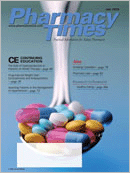Publication
Article
Pharmacy Times
A Pharmacist's Guide to OTC Therapy: OTC Products for Acne Vulgaris
Author(s):
Everyone experiences some degree of acne. Acne affects approximately 85% of individuals between the ages of 15 and 24 years.1 It typically manifests itself during the ages of 12 to 18 years in males and 15 to 17 years in females.
There are 2 categories of acne1:
- Noninflammatory acne?characterized by the presence of closed or open comedones, commonly referred to as whiteheads (closed comedones) and blackheads (open comedones)
- Inflammatory acne?characterized by pimples that appear as small inflamed elevations of the skin
Typically, individuals exhibit a combination of both types of acne in areas where the sebaceous glands are the most prominent. Although the facial area is the most prevalent site, acne also can develop in other areas such as the chest and back, as well as on the neck and upper arms.
Factors that may worsen or precipitate acne include the following:
- Use of cosmetics
- Emotional factors, such as stress and anxiety
- Environmental factors, such as humidity or exposure to dirt
- Hormonal factors (premenstrual changes)
- Use of certain medications
Pharmacists should inform patients that certain prescription medications can worsen acne. Examples of these agents include phenytoin, isoniazid, phenobarbital, lithium, quinine, rifampin, and steroids.1
Pharmacologic Treatments
A wide variety of topical nonprescription products are available for treating acne (Table). Nonprescription products contain active ingredients such as benzoyl peroxide, salicylic acid, or sulfur and may be single-entity or combination products.They are available in a variety of dosage forms, such as gels, lotions, creams, cleansers, masks, and soaps.
Benzoyl peroxide typically is used twice daily. Salicylic acid products are used mainly as cleansers and then rinsed off. Sulfur-containing products usually are used 1 to 3 times daily.
The Role of the Pharmacist
In addition to assisting patients in the appropriate selection and use of nonprescription acne treatment preparations, pharmacists should suggest nonpharmacologic acne treatments, as well as preventive measures that may reduce outbreaks. Establishing a twice-a-day skin-cleansing routine using warm water and facial soap without moisturizers is one preventive measure that can be recommended. Avoiding or lessening the exposure to factors that may cause acne flare-ups also can be recommended.
Patients should be reminded that, in order for treatment to be effective, compliance is necessary. Strict adherence to skin-care regimens is crucial to controlling outbreaks of acne and minimizes the effects of scarring. Patients with severe cases of acne always should be referred to a dermatologist for further evaluation and treatment.
Ms. Terrie is a clinical pharmacy writer based in Haymarket, Va.
For a list of references, send a stamped, self-addressed envelope to: References Department, Attn. A. Stahl, Pharmacy Times, 241 Forsgate Drive, Jamesburg, NJ 08831; or send an e-mail request to: astahl@ascendmedia.com.







